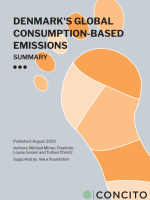Denmark's global consumption-based emissions
According to CONCITO's updated assessment of Denmark's global consumptionbased emissions, each Dane emits an average of 13 tonnes of CO2e annually, which is about twice as much as an average world citizen. The largest share of emissions come from the Danish consumption of transportation, food, housing and energy, but there are also significant emissions from consumption in the public sector, through leisure and culture, and the use of clothing, personal care and furniture.
Major changes in Danish consumption patterns and lifestyles are needed if Denmark is truly to be a green pioneer that can credibly inspire other countries to take the necessary climate action as well. If we are to align ourselves with the Paris Agreement and the IPCC’s 1.5-degree target, swift and transformative action is needed at both individual and systemic levels, as global greenhouse gas emissions must be roughly halved by 2030 compared to emission levels of 2020.
The report calculates Denmark's total global consumption-based emissions to be at 74 million tonnes of CO2 equivalents (CO2e). The new result represents a reduction compared to an earlier CONCITO estimate from 2014. This reduction owes more to cleaner energy production than to any significant change in Danish consumption habits
Key results
- Denmark's total global consumption-based emissions are at 74 million tonnes CO2e.
- This corresponds to 13 tonnes CO2e per capita.
- This is a reduction of 4 tonnes CO2e compared to CONCITO's previous assessment of 17 tonnes.
- Real reductions are estimated to be of 3 tonnes co2e per person, whereas the remaining 1 tonne is estimated to be due to differences in methodology and data quality.
- The consumption domains responsible for the highest shares of emissions are transportation, food, public services, electricity and heat, and housing. Other product groups and services with the highest total emissions include leisure and culture, clothing and textiles, personal care, furniture and home furnishings, insurance, and finance.
Full report (in Danish)
Presentations from the launch conference (in Danish)
Appendix:
The results in the report are calculated by 2.-0 LCA consultants and based on data and modeling from Aalborg University's "Getting the data right" project and EXIOBASE update project.





